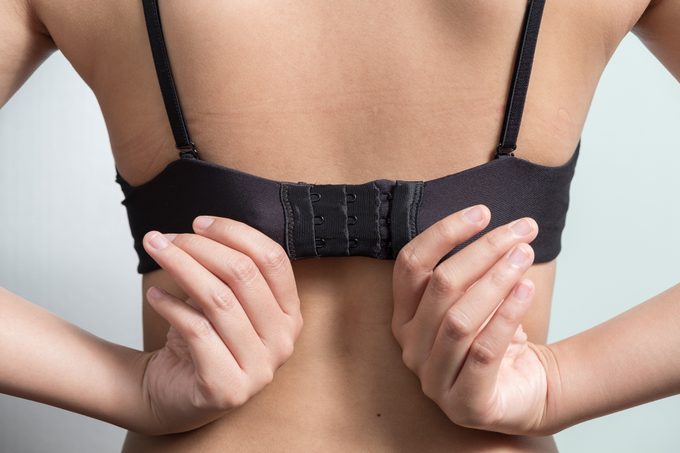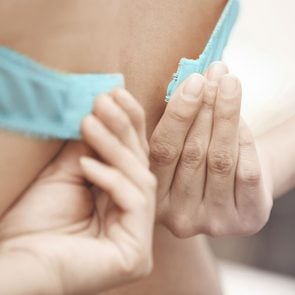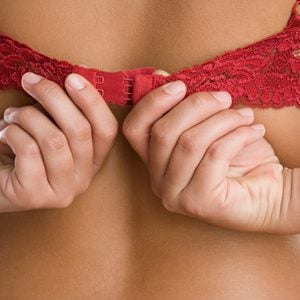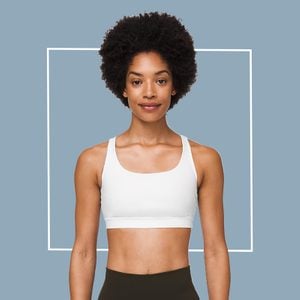7 Signs You’re Wearing the Wrong Bra Size—And How to Find One That Fits
Updated: Oct. 11, 2022
Use this bra size guide to find out how to measure your bra size, know when a bra doesn't really fit you, and finally find a bra that's the right size for you.
Our editors and experts handpick every product we feature. We may earn a commission from your purchases.
Bras should be supportive and comfortable, not irritating
Taking off your bra after a long day is something most bra wearers anticipate with joy. Although you likely have a few go-to bras you wear on repeat, there is probably more than one you wear begrudgingly on laundry day that just doesn’t fit right. Heck, you might be tempted to go braless.
Not only can wearing the wrong size bra be uncomfortable, but it can also be bad for your breasts. Finding the right size bra that’s flattering and fits doesn’t have to be complex. (If you’re working out, be sure to choose one of the best sports bras.)
Check out the signs you’re wearing the wrong size bra and how to use our bra size guide to find one that fits, according to lingerie experts.
How should a bra fit?
After wearing the wrong size bra for a while, you might not recognize or know exactly how one should fit. A well-fitting bra is one you don’t feel or think about during the day as it keeps the breasts in place and does not need readjusting, according to Josie-Anne Le Diouron, French lingerie brand Empreinte’s bra fitting expert.
Helena Kaylin, founder of MINDD Bra Co in West Hollywood, California, adds that we all feel and interpret support differently.
“It’s about comfort, and comfort is also about a feeling,” she says. “Your bra should feel good, and it shouldn’t be something you’re thinking about.” It should be flexible and adapt or conform to your shape.”
Does my bra fit?
You can evaluate if a bra fits well. Try it on with a close-fitting garment on top like a simple white stretch T-shirt, Le Diouron suggests. “It makes it easier to self-evaluate if the actual shape that the bra gives to your breast meets your expectation.” (Here are the ways your breasts change with age.)
Le Diouron and Genelle Beyer, an image consultant, personal stylist, and bra fit specialist in Wisconsin, both say there are four main things to check if your bra fits well—the band, the straps, the cups, and the center of the bra between the cups (called the gore). Here’s what to look out for and how to fix these common bra fit woes.
Signs your bra doesn’t fit
Yes, you’re probably wearing the wrong bra size—and you’re not alone. Wearing the wrong bra size is a health issue since it can lead to or exacerbate neck, back, or breast pain. A 2018 study in Orthopaedic Proceedings found that women with larger breasts who experience back pain saw an improvement after wearing correctly fitting bras.
So it makes sense that you want a bra that fits. But first it’s key to recognize the following signs that your bra does not fit properly.
(Here’s what your breasts wish they could tell you.)

Band
The band is too tight or too loose
One of the signs your bra doesn’t fit is if the band rides up into an arch or a rainbow-like figure on your back, according to Beyer. The band should not ride up in the back nor the front. Instead, it should create a parallel line to the floor straight across your back. “It should run parallel along the rib cage under the ‘root’ of the breast,” she says.
The band should be snug, but not tight, according to Kaylin. You need to be able to breathe, but it shouldn’t be so loose that it’s unsupportive. Sometimes snug will look like it’s digging in, and it may not be.
One tip from Kaylin to keep your bra band from outstretching is to always start on the loosest hook and eye closure, not the tightest. “The purpose of having multiple hooks and eyes is that over time, your bra will naturally become looser, so you have that flexibility to come to the middle and tightest hook over time.”
Straps
The straps are falling down
The straps of a well-fitting bra should stay on the shoulders all day long and not need readjusting, Le Diouron says. Of course, they might become loose after a couple of wears and washings, at which point you should adjust them as necessary. Or you may, in fact, be wearing a bra that is too big for you, Kaylin says.
People may think the simple answer for loose straps is always to adjust and tighten them accordingly. But one mistake Beyer sees with her clients is tightening bra straps to the point of pulling the entire brassiere up on the body. (Find out whether it’s unhealthy to sleep with an underwire bra.)
“Straps should rest securely on your shoulders, not digging in or falling off the shoulders,” Beyer says. “They should run perpendicular to the band, and ideally, should not have to be constantly adjusted by pulling closer to your neck.”
Of course, they may also be dependent on your shoulders’ natural shape, and there are specific bras that will function best for your body type. If you have sloping shoulders, you may want to consider a racerback. You could also invest in a little bra accessory–like Thsinde bra straps clips—which allow you to pull the straps together on your back to convert to racerback, Beyer recommends. Some bras even come with these little attachments or “J hooks” to convert to a racerback.
If straps refuse to stay on your shoulders no matter how much you tighten them, you’re wearing the wrong size. Remember: Your straps may be keeping the “girls” up, but it is the band that truly supports your breasts’ placement.
When tightening straps, place fingers to the exact point of comfort, then pull and adjust straps to suit. If no amount of strap tightening or loosening works, chances are you are wearing the wrong band size, according to Beyer.
Take a look at the quality of the straps, too. It’s possible after normal wear that they have lost all the power of the elastic.
The straps dig into your skin
If your straps dig in, it means that they do all the heaving lifting. Straps that do most of the work cause back, shoulder, and neck pain, according to Kaylin. Remember that your straps should provide support, but not the only support for your bust. If you’ve done all the adjusting you can, it’s not you, it’s the bra.
Cups
The cups gape
A gap between the breast and the cup means you’re wearing the wrong size and should go down a cup size, Le Diouron recommends. The edges of the cup should fall flush against your skin with no excess breast tissue hanging out.
You may automatically adjust to a lower cup size, but still carefully assess how the band feels. There is a likelihood you may have to change your band size as well. However, it may also be possible that that style does not work for your breast and body type. “Be open to trying different bra styles, such as molded cup versus unlined or wired versus wire-free,” Beyer says.
If you only feel comfortable in a foam-lined cup, find a lightly lined bra or one called a spacer, according to Kaylin. “Spacer is this wonderful technology that is more flexible and less rigid than some foam cups,” she says.
Gaping cups may also be a result of how you store your molded cup bras. Beyer recommends laying bras flat with the natural molded shape intact. “Do not fold cups in half into each other for storage,” she warns. “This will misshape the bra cups, which can, in fact, lead to a less than desirable fit.” (Be sure you also avoid these underwear mistakes.)
The cups have “spillage”
On the other end of the spectrum, if your breasts always spill out of the top of the cup, you should go up a cup size. Many women Kaylin meets don’t actually know their proper cup size. “I have met hundreds of women who would tell me they are a C cup, and they are really a D or DD cup,” she says. “I would tell them they are in D-enial.”
As a start, Kaylin recommends going up a cup size, especially if your band feels good. Contact the bra company because each company is different depending on the materials they use to make the bras.
Gore
Wires or the gore irritate your skin
The gore is the center of the bra between the two cups where the underwire seems to meet. It should rest comfortably against your sternum, allowing for reasonable separation between the breasts. If the gore floats above the breast tissue, you’re wearing the wrong size.
Kaylin adds that the shape of the wire helps protect your breasts. “You should really never feel the wire casing,” Kaylin says. “If you do, it will cause irritation in the long run.”
(If you’re in the market for a new bra, you might want to also refresh the rest of your lingerie with the healthiest women’s underwear.)
How to measure bra size
The first thing is to accept that bodies literally change on a daily basis. Minor fluctuations will create slight changes when it comes to finding the right bra size. During your cycle, some women experience more fluctuation in sizes. So it helps to track the changes, if possible.
Although a professional fitter is an ideal way to find your bra size, here’s a bra size guide from Kaylin on how to find your perfect fit.
You’ll need to know two measurements: band and cup size. “If you have a measuring tape and a friend or spouse you are in quarantine with, have them help you out,” she says. “It is important to make sure the measuring tape is straight. It is sometimes harder to do on your own.”
- Measure directly under your breasts. Breathe in and out. Make sure the tape is snug, but not tight. Write down that number. If it is an odd number like 35, go up to an even number.
- Take the measuring tape and measure across the fullest point of your breasts, typically across the apex. Write down that number.
- Now, subtract this number by the first measurement. For example, let’s say, 42 – 36 = 6. There is a 6-inch variance between these numbers. Every inch is a cup size. An A cup is 1 inch. B cup 2 inches. C cup 3 inches.
Now that you’ve read our bra size guide, check out whether you should wear undergarments to bed.



